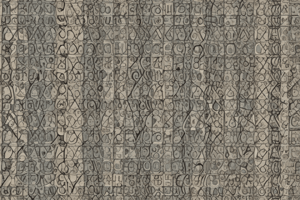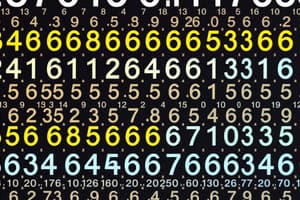Podcast
Questions and Answers
What is a sequence of numbers that follows a specific rule or formula?
What is a sequence of numbers that follows a specific rule or formula?
- Number pattern (correct)
- Geometric sequence
- Arithmetic sequence
- Fibonacci sequence
In an arithmetic sequence, each term is obtained by?
In an arithmetic sequence, each term is obtained by?
- Adding a fixed constant to the previous term (correct)
- Multiplying the previous term by a fixed constant
- Dividing the previous term by a fixed constant
- Subtracting a fixed constant from the previous term
What is the sequence of numbers in which each term is the sum of the two preceding terms?
What is the sequence of numbers in which each term is the sum of the two preceding terms?
- Geometric sequence
- Arithmetic sequence
- Exponential sequence
- Fibonacci sequence (correct)
What is a single number in a sequence?
What is a single number in a sequence?
What is the term that comes after a given term in a sequence?
What is the term that comes after a given term in a sequence?
In what field is the pattern of stock prices or economic trends an application of number patterns?
In what field is the pattern of stock prices or economic trends an application of number patterns?
Flashcards are hidden until you start studying
Study Notes
Introduction to Number Patterns
- A number pattern is a sequence of numbers that follow a specific rule or formula.
- Number patterns can be found in nature, art, and mathematics.
Types of Number Patterns
- Arithmetic Sequences: A sequence of numbers in which each term is obtained by adding a fixed constant to the previous term.
- Example: 2, 5, 8, 11, ...
- Geometric Sequences: A sequence of numbers in which each term is obtained by multiplying the previous term by a fixed constant.
- Example: 2, 6, 18, 34, ...
- Fibonacci Sequence: A sequence of numbers in which each term is the sum of the two preceding terms.
- Example: 0, 1, 1, 2, 3, 5, 8, ...
Characteristics of Number Patterns
- Rule: A formula or equation that defines the pattern.
- Term: A single number in the sequence.
- Next Term: The term that comes after a given term in the sequence.
- Previous Term: The term that comes before a given term in the sequence.
Creating Number Patterns
- Start with a Rule: Identify the rule or formula that defines the pattern.
- Use the Rule to Generate Terms: Apply the rule to generate each term in the sequence.
- Recognize Patterns: Look for relationships between terms to identify the pattern.
Real-World Applications of Number Patterns
- Science: Patterns in nature, such as the arrangement of leaves on a stem or the branching of trees.
- Finance: Patterns in stock prices or economic trends.
- Computer Science: Patterns in algorithms and data structures.
Introduction to Number Patterns
- A number pattern is a sequence of numbers that follow a specific rule or formula, and they can be found in nature, art, and mathematics.
Types of Number Patterns
- Arithmetic Sequences: Each term is obtained by adding a fixed constant to the previous term, e.g., 2, 5, 8, 11,....
- Geometric Sequences: Each term is obtained by multiplying the previous term by a fixed constant, e.g., 2, 6, 18, 34,....
- Fibonacci Sequence: Each term is the sum of the two preceding terms, e.g., 0, 1, 1, 2, 3, 5, 8,....
Characteristics of Number Patterns
- Rule: A formula or equation that defines the pattern.
- Term: A single number in the sequence.
- Next Term: The term that comes after a given term in the sequence.
- Previous Term: The term that comes before a given term in the sequence.
Creating Number Patterns
- Start with a Rule: Identify the formula or equation that defines the pattern.
- Use the Rule to Generate Terms: Apply the rule to generate each term in the sequence.
- Recognize Patterns: Look for relationships between terms to identify the pattern.
Real-World Applications of Number Patterns
- Science: Patterns in nature, such as the arrangement of leaves on a stem or the branching of trees.
- Finance: Patterns in stock prices or economic trends.
- Computer Science: Patterns in algorithms and data structures.
Studying That Suits You
Use AI to generate personalized quizzes and flashcards to suit your learning preferences.




